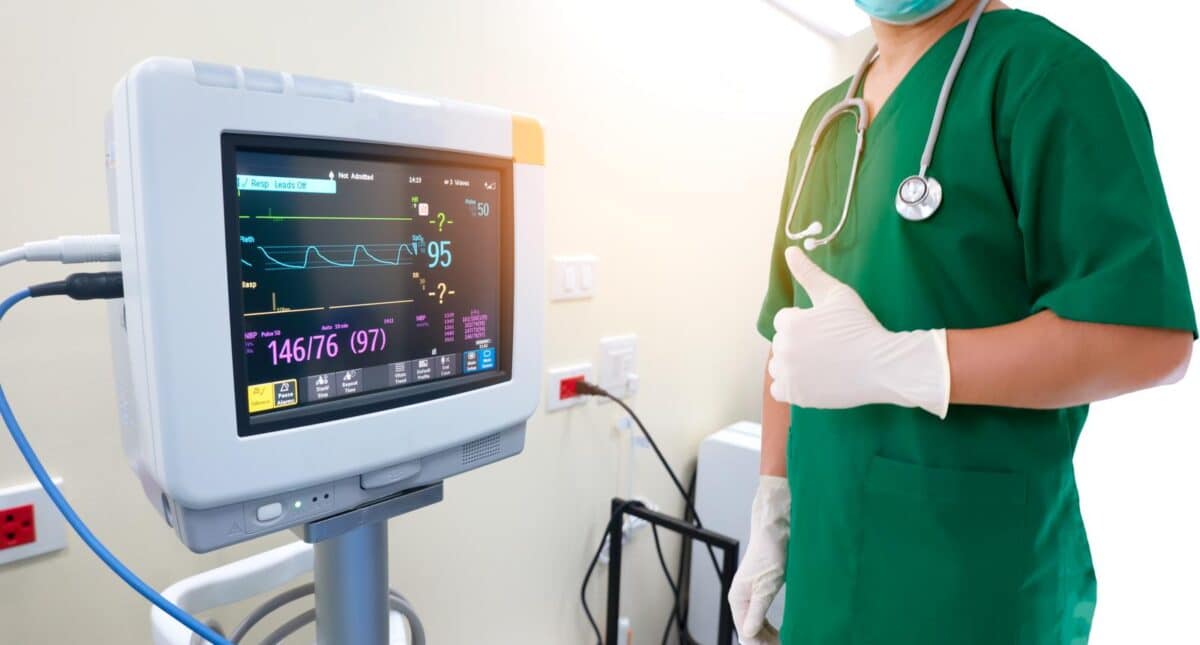How To Read An Electrocardiogram (EKG/ECG)
How To Read An Electrocardiogram (EKG/ECG)
Have you ever looked at an electrocardiogram (EKG/ECG) and felt completely confused? With all those squiggly lines and strange markings, it can seem like a foreign language. But fear not, understanding how to read an EKG is not as difficult as it may seem.
Electrocardiograms are an essential tool in diagnosing and monitoring heart conditions. Doctors and healthcare professionals use EKGs to analyze the electrical activity of the heart and detect any abnormalities. However, interpreting an EKG requires knowledge and practice.
In this article, we will break down the basics of reading an EKG, making it easier for you to understand and interpret the information it provides. By learning the key components and patterns to look for, you’ll be able to gain valuable insights into the health of your heart or those of your patients. So, let’s dive into the world of electrocardiograms and unlock the secrets they hold.
Importance Of Understanding ECG
Understanding ECG (Electrocardiogram) is crucial in the field of medicine. It is a diagnostic tool that measures the electrical activity of the heart rhythm and provides valuable information about its function and health.
Healthcare professionals, such as doctors and nurses, need to have a comprehensive understanding of ECG to accurately interpret the readings and identify any potential abnormalities or irregularities in the heart’s rhythm. This knowledge allows them to diagnose and treat various cardiovascular conditions effectively.
Moreover, understanding ECG also helps in monitoring the effectiveness of certain medications and treatments, providing important insights into a patient’s overall cardiac health and aiding in the management of cardiac diseases. Therefore, the importance of understanding ECG cannot be overstated in the medical field.
Understanding The ECG WaveForm

Electrodes
Electrodes are small, adhesive patches or suction cups that are placed on specific locations on the body to detect the electrical activity of the heart. Typically, a standard ECG uses 10 electrodes – 6 on the chest and 4 on the limbs.
Leads
Leads are electrical connections between the electrodes and the ECG machine. They transmit the electrical signals generated by the heart to the machine for analysis. The standard ECG uses 12 leads, which are a combination of limb leads (I, II, III, aVR, aVL, aVF) and chest leads (V1-V6).
Paper Strip Or Digital Display
The ECG machine produces a visual representation of the electrical activity of the heart on a paper rhythm strip or digital display. This waveform is called an electrocardiogram or ECG. The paper strip or digital display provides a visual record that can be analyzed by healthcare professionals.
P Waves
Depolarization (contraction) of the atria, the upper chambers of the heart, is represented by the P wave. It shows the electrical activation of the atria (the two upper chambers of the heart) as they contract to pump blood into the ventricles (the two lower chambers of the heart).
QRS Complex
The QRS complex represents the depolarization (contraction) of the ventricles, the lower chambers of the heart. It consists of a Q wave, an R wave, and an S wave. The Q-wave is the first downward deflection, the R-wave is the first upward deflection, and the S-wave is the first downward deflection following the R-wave. Abnormalities in the QRS complex can indicate various cardiac conditions.
T Waves
T waves represent the ventricles’ repolarization (recovery) after contraction. It is a slightly asymmetrical waveform that follows the QRS complex. It is the period during which the ventricles are resetting their electrical state to prepare for the next heartbeat. Abnormalities in the T-wave can be seen in various cardiac conditions.
ST Segment
The ST segment is the flat, horizontal section of the ECG waveform that follows the QRS complex and precedes the T wave. It represents the period when the ventricles are depolarized, and it should be at the baseline (equal to the PR segment). Deviations in the ST segment can be indicative of myocardial ischemia or injury. Changes in the ST segment can indicate conditions such as myocardial ischemia or infarction.
QT Interval
The QT interval measures the total time it takes for the ventricles to depolarize and repolarize. It starts at the beginning of the QRS complex and ends at the end of the T wave. Prolongation or shortening of the QT interval can be indicative of certain heart conditions or medication effects.
PR Intervals
The PR interval measures the time it takes for the electrical signal to travel from the atria to the ventricles. It starts at the beginning of the P wave and ends at the beginning of the QRS complex. The PR interval is important in assessing the conduction of electrical signals through the heart.
U-Wave
The U-wave is not always prominent and not always seen on every ECG. It follows the T-wave and represents the repolarization of the Purkinje fibers, which are specialized cells involved in the conduction of electrical signals within the heart. The U-wave is not always clearly visible and can sometimes indicate electrolyte imbalances or other cardiac issues when present.
Understanding the basic components of an ECG can help healthcare professionals interpret the electrical activity of the heart and diagnose various heart conditions.

Analyzing The Heart Rate And Rhythm
Analyzing heart rate and rhythm is an important part of assessing cardiovascular health and identifying potential issues with the heart. Various factors can affect heart rate and rhythm, and understanding them can provide valuable insights into a person’s overall well-being. Here are some key concepts and steps involved in analyzing heart rate and rhythm:
Calculating Heart Rate
Calculating heart rate is a basic yet crucial step in analyzing the heart’s function. To calculate heart rate, locate a pulse point (such as the wrist or neck) and count the number of beats felt within a specific time frame. By dividing the number of beats by the time frame (usually in seconds) and multiplying by 60, you can determine the heart rate in beats per minute.
In adults, the normal resting heart rate typically ranges from 60 to 100 bpm. However, athletes and physically fit individuals may have lower resting heart rates due to their increased cardiovascular efficiency.
Identifying Regular And Irregular Rhythms
Identifying whether a heart rhythm is regular or irregular is an important step in monitoring cardiac health. A regular rhythm will have a consistent time interval between each beat, while an irregular rhythm will show variation in these intervals. To identify irregularities, listen carefully to the timing of each beat or use an electrocardiogram (ECG) for a more accurate analysis.
Recognizing Common Arrhythmias (E.G., Atrial Fibrillation, Ventricular Tachycardia)
- Atrial Fibrillation: Atrial fibrillation is the most common type of arrhythmia, characterized by irregular, rapid, and chaotic electrical impulses in the atria. This condition can lead to poor blood flow and increase the risk of stroke or heart failure. Symptoms may include palpitations, shortness of breath, and fatigue.
- Ventricular Tachycardia: Ventricular tachycardia is a rapid heart rhythm originating from the ventricles. It is often associated with pre-existing heart conditions, such as coronary artery disease or previous heart attacks. Ventricular tachycardia can be life-threatening and may manifest as chest pain, dizziness, or fainting.
Assessing The Electrical Axis Of The Heart
The electrical axis of the heart refers to the average direction of electrical activation as it travels through the heart. It is an important aspect of assessing the health and function of the heart. Here are two key components of assessing the electrical axis of the heart:
Determining The QRS Axis
The QRS axis is a measurement that determines the direction in which the electrical impulses are spreading through the ventricles. It is determined by analyzing the QRS complex on an electrocardiogram (ECG). Here’s how to determine the QRS axis:
The QRS axis is a measurement that determines the direction in which the electrical impulses are spreading through the ventricles. It is determined by analyzing the QRS complex on an electrocardiogram (ECG). Here’s how to determine the QRS axis:
- Obtain a 12-lead ECG: A 12-lead ECG is necessary to accurately determine the QRS axis. It provides a comprehensive view of the electrical activity of the heart from different angles.
- Identify the QRS complex: The QRS complex represents the electrical impulses spreading through the ventricles. It consists of the Q, R, and S waves.
- Determine the lead with the most positive QRS complex: Examine the QRS complex in leads I and aVF. If the QRS complex in lead I is more positive than in aVF, the axis is normal or left axis deviation. If the QRS complex in aVF is more positive, it indicates right axis deviation.
- Determine the quadrant in which the QRS complex resides: Once you determine whether it’s normal, left axis deviation, or right axis deviation, you can determine further details about the electrical axis by identifying the specific quadrant on the hex axial reference system. This system divides the 360-degree circle into six parts, each representing a specific axis deviation.
Interpreting Normal, Left Axis Deviation, And Right Axis Deviation
- A normal axis means that the electrical impulses are flowing through the heart in a normal direction. The QRS complex will be mostly positive in lead I and positive in aVF. The normal electrical axis ranges from -30 to +90 degrees. This indicates a healthy functioning heart.
- Left axis deviation occurs when the electrical impulses deviate towards the left side of the heart. In this case, the QRS complex will be more positive in lead aVF than in lead I. The electrical axis typically ranges between -30 and -90 degrees. Left axis deviation can be seen in conditions such as left ventricular hypertrophy or conduction abnormalities.
- Right axis deviation occurs when the electrical impulses deviate towards the right side of the heart. The QRS complex will be more positive in lead I than in aVF. The electrical axis typically ranges between +90 and +180 degrees. Right axis deviation can be seen in conditions such as right ventricular hypertrophy or conditions affecting the right side of the heart.

Identifying Myocardial Ischemia And Infarction
Ischemia refers to a lack of blood flow and oxygen to the heart muscle, while infarction refers to tissue death due to a complete blockage of blood flow. On an EKG/ECG, differentiating between ischemia and infarction can be challenging.
However, certain changes can help distinguish between the two. Ischemia may manifest as ST segment depression, T wave inversion, or the appearance of U waves. In contrast, infarction is usually associated with significant Q wave changes and persistent ST-segment elevation.
Understanding Myocardial Ischemia
Myocardial ischemia occurs when there is a reduced blood supply to the heart muscle, typically due to a blockage in the coronary arteries. The lack of oxygen-rich blood can lead to chest pain or discomfort, known as angina. Identifying myocardial ischemia involves recognizing the following signs:
- Chest Pain: The most common symptom of myocardial ischemia is chest pain or discomfort. It is often described as a squeezing or pressing sensation in the chest. The pain may also radiate to the arms, jaw, back, or neck.
- Shortness of Breath: Individuals experiencing myocardial ischemia may have difficulty breathing or sudden shortness of breath, even during rest or minimal exertion.
- Fatigue and Weakness: Feeling excessively tired or weak, even after minimal physical activity, can be an indication of reduced blood flow to the heart.
- Nausea and Indigestion: Some people may experience feelings of nausea, abdominal discomfort, or indigestion during a myocardial ischemic episode.
Identifying Myocardial Infarction
Myocardial infarction, also known as a heart attack, occurs when there is a complete blockage in one or more coronary arteries, leading to the death of heart muscle cells. Identifying a heart attack involves recognizing the following signs:
- Severe Chest Pain: Unlike myocardial ischemia, chest pain during a heart attack is often more intense and prolonged. It can be described as a feeling of pressure, tightness, or squeezing that may last for several minutes.
- Pain Radiating to Other Areas: The pain may spread beyond the chest to the arms (commonly the left arm), jaw, back, or neck. It is important to note that some individuals may experience minimal or no chest pain but instead feel discomfort in these other areas.
- Shortness of Breath: Similar to myocardial ischemia, shortness of breath can be present during a heart attack. It may occur with or without chest pain.
- Nausea, Dizziness, and Sweating: Some individuals may experience additional symptoms like nausea, lightheadedness, dizziness, cold sweats, or feeling extremely clammy.
- Women and Elderly Individuals: It is important to note that women and elderly individuals may present with atypical symptoms such as fatigue, weakness, or shortness of breath without chest pain during a heart attack. This makes it crucial to consider other signs and symptoms in these populations.
Recognizing Conduction Abnormalities
Bundle Branch Blocks
Bundle branch blocks occur when there is a delay or blockage of electrical signals in the heart’s bundle branches. Look for widened QRS complexes (greater than 0.12 seconds) and examine the shape and direction of the QRS complex. A left bundle branch block (LBBB) will have a wide and slurred QRS complex, while a right bundle branch block (RBBB) will show a wide QRS with an upward slant on the ST segment in leads V1 and V2.
Atrioventricular (AV) Blocks
AV blocks occur when there is a disruption in the electrical signals between the atria and the ventricles. There are three types of AV blocks: first-degree, second-degree, and third-degree (also known as complete heart block).
- First-Degree AV Block: In a first-degree AV block, every electrical impulse reaches the ventricles but is delayed. This delay is seen as a prolonged PR interval (greater than 0.20 seconds) on the EKG/ECG.
- Second-Degree AV Block: Second-degree AV blocks are divided into two types: Mobitz Type I (Wenckebach) and Mobitz Type II. In Mobitz Type I, there is a progressive prolongation of the PR interval until one complete beat is dropped. Look for a repeating pattern of prolonged PR intervals followed by a dropped beat. In Mobitz Type II, there is an intermittent failure of electrical signals to reach the ventricles, resulting in a dropped beat without progressive PR interval prolongation.
- Third-Degree AV Block (Complete Heart Block): In a complete heart block, there is a complete disconnection between the atria and ventricles. This is seen as no association between P waves and QRS complexes. The atria and ventricles beat independently, each with their own regular rhythm.
Interpreting EKG Changes In Common Clinical Scenarios
EKG In Acute Chest Pain
Acute chest pain is a common symptom that requires immediate medical attention. When analyzing an EKG in this scenario, the following key points should be considered:
- Look for ST-segment elevation or depression, as these changes may indicate a myocardial infarction (heart attack).
- Examine the presence of Q waves, which can suggest a previous heart attack.
- Pay attention to T wave inversions, which may indicate ischemia or lack of oxygen to the heart.
EKG In Syncope
Syncope, or fainting, is another critical scenario where an EKG can provide valuable information. When evaluating an EKG in this situation, consider the following factors:
- Assess the presence of arrhythmias such as bradycardia or tachycardia, as they can cause syncope.
- Look for prolonged QT intervals, which may suggest an underlying arrhythmia called long QT syndrome.
- Check for subtle changes in the PR interval, as abnormalities can indicate a heart block.
EKG In Drug Overdose
Drug overdose can have significant effects on the cardiovascular system, making EKG interpretation crucial for prompt intervention. Here are some key points to keep in mind:
- Monitor for QT interval prolongation, as certain drugs can cause a potentially fatal arrhythmia called torsades de pointes.
- Look for widened QRS complexes, which may indicate sodium channel-blocking drug toxicity.
- Assess for ST-segment changes or other abnormalities that could indicate myocardial ischemia or infarction caused by drug-induced vasoconstriction.

Pitfalls And Limitations Of EKG Interpretation
Artifact And Technical Errors
One of the major pitfalls in EKG interpretation is the presence of artifacts and technical errors. Artifact refers to any interference or abnormality in the EKG reading that is not a result of the heart’s electrical activity. This could include movement artifacts, muscle tremors, poor electrode placement, or electrical interference from nearby equipment. These artifacts can lead to inaccurate readings and misinterpretation of the EKG.
False Positives And False Negatives
False positives occur when the EKG interpretation suggests the presence of a cardiac abnormality or condition when there is actually none. This can happen due to factors such as poor lead placement, electrical interference, or misinterpretation of normal variations in the EKG waveforms. False positives can lead to unnecessary further testing, treatment, and anxiety for patients.
On the other hand, false negatives occur when the EKG interpretation fails to detect a cardiac abnormality or condition that is actually present. This can happen due to various reasons, including technical errors, limited lead placement, or subtle changes in the EKG waveforms that are difficult to recognize. False negatives can lead to missed diagnoses and delayed or inadequate treatment for patients.
Limited Lead Placement
EKG interpretation heavily relies on electrode placement on the patient’s body to obtain accurate readings. However, due to anatomical limitations or patient positioning, it may not always be possible to obtain all the necessary leads for a comprehensive EKG. This limited lead placement can result in the interpretation missing certain cardiac abnormalities or conditions that could be detected with a more complete EKG recording.
Inadequate Training And Experience
EKG interpretation requires specialized knowledge and experience. It is important for healthcare professionals and clinicians to undergo comprehensive training on EKG interpretation to ensure accurate diagnosis and appropriate management. Inadequate training and lack of experience can lead to misinterpretation of EKG readings, potentially leading to incorrect diagnoses and inappropriate treatments.
Variations In EKG Waveforms
EKG waveforms can vary significantly among individuals due to differences in anatomy and electrical conduction. These natural variations can sometimes make it challenging to differentiate normal variations from abnormal findings. This can result in errors in EKG interpretation and the potential for false positives or false negatives.
Subtle Or Silent Cardiac Abnormalities:
Some cardiac abnormalities may not manifest with obvious EKG changes, making them difficult to detect through EKG interpretation alone. These subtle or silent abnormalities may require additional diagnostic tests, such as echocardiography or stress testing, to confirm the presence of any underlying cardiac pathology.
Conclusion And Key Takeaways
Understanding how to read an electrocardiogram (EKG/ECG) is a valuable skill for healthcare professionals and anyone interested in monitoring their heart health. By familiarizing yourself with the basic components of an EKG and interpreting the various waveforms and intervals, you can gain crucial insights into a patient’s cardiac activity.
Remember, proper placement of the electrodes, careful examination of the P, QRS, and T waves, and analyzing the intervals can provide vital information about rhythm disturbances, heart rate, and overall heart health. Additionally, paying attention to any abnormalities or deviations from the norm can help identify potential cardiac conditions or complications.
While interpreting an EKG may seem complex at first, with practice and continued learning, you can become proficient in reading and understanding this valuable diagnostic tool. Ultimately, mastering the skill of interpreting EKGs enhances your ability to provide timely and accurate assessments, leading to better patient care and outcomes.
So, whether you’re a healthcare professional or someone curious about your own heart health, investing time and effort in learning how to read an EKG is undoubtedly a worthwhile endeavor. It opens up a whole new world of knowledge and empowers you to make informed decisions regarding your cardiac health or the well-being of those in your care.
